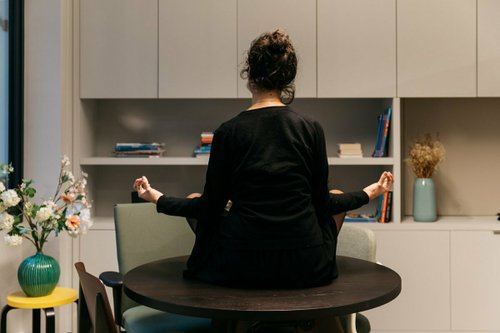How are businesses reinventing their working spaces?
Jun 18, 2019
6 mins

TB
Open-plan spaces, flex offices, coworking…new kinds of office concepts and new ways of working in these spaces have flourished over the past few years. And at the same time, the divide between the professional world and private life has been disappearing, with large numbers of employees now periodically working from home or from the terrace of a café. What will tomorrow’s office spaces be like, and how can businesses adapt to them? This is the question we posed to Audrey Barbier Litvak, General Manager at WeWork France, and Laëtitia Vitaud, a writer and lecturer on the future of work.
Having a job is a good thing. But having a workspace that’s properly suited to us makes it even better. The geographical location of the offices, which is an important deciding factor from the candidate’s point of view, represents one of the primary challenges businesses need to get right. «Getting to live in the centre of the most attractive towns and cities is one of the main concerns today: San Francisco, London, Paris – these are absolutely the places where workers, especially the creative classes, want to be» explains Laëtitia Vitaud, a writer and lecturer on the future of work. «The problem is that there are fewer and fewer places available and rents are getting more and more expensive…» This is an observation Audrey Barbier Litvak, General Manager of WeWork’s coworking spaces in France, completely agrees with. «People often ask me when we’ll be opening premises in Lille, at La Défense, etc. And the truth is I just don’t know! Because in fact, both companies and workers want to be right at the very centre of Paris. We have 20 projects involving premises in Paris to undertake first, before we can even think about heading out to the inner suburbs.» Even Lyon, the main city in the region where WeWork wants to have a presence, will probably not open before… 2020.
Providing different types of spaces
When it comes to being attractive to potential employees, however, it isn’t enough just to have the right geographic location. The internal layout and organisation of the premises also counts, both in terms of attracting staff and… increasing employee productivity. «There are no hard and fast rules however» explains Laëtitia Vitaud. In other words, there are no catalogues of furnishings and fittings or ergonomy tutorials to follow to the letter. It’s up to everyone to work out what their own employees needs are. «The only thing the various studies conducted so far have demonstrated is that we become more productive when we have interest shown in us.» Armed with this observation, WeWork has reworked its spaces as follows: «We realised that the more that people could see each other, the more they interacted and the more productivity increased.» The primary element of WeWork’s ergonomic measures: extremely open-plan spaces, with windows absolutely everywhere and lots of light.
The only thing the various studies conducted so far have demonstrated is that we become more productive when we have interest shown in us.
But behind the growth and increase in the use of open-plan spaces and glass dividing walls, the question really being asked is one of. «It is important to make the distinction between two types of working: what we refer to as ‘Deepwork’, which is all those tasks involving creative processes and requiring high levels of concentration; and what we refer to as ‘shallow work’, which consists of networking and contact type work, management work, and the work that simply arises by chance». Laëtitia Vitaud summarises the situation thus: «You need to ensure you provide different types of spaces in accordance with the needs of each particular profession.» An entire room offering peace and quiet; little cocoons in corners of open-plan spaces; or single-person, sound-proofed, closed cubicles – various solutions are available when it comes to creating out-of-the-way spaces workers can go for peace and quiet, and to concentrate.
The one concept that really counts: that the employee has the choice
So, if each individual requires a specific kind of space depending on the work they happen to be doing at any given time, is the Flex office, the trend that advocates having no individually allocated offices, the panacea everyone has been waiting for? Not as far as lecturer Laëtitia Vitaud is concerned, for whom this choice, if it’s imposed, is something people can find very difficult to deal with. «Some individuals experience the absence of their own personal office asa real and genuine loss. You no longer know where to put your things; you no longer have a space you can personalise so you feel happy and comfortable there… Going from zero flex office to 100% flex office often proves not to be a good idea.» Essentially, she maintains, this kind of layout and approach should be left to certain specific professions. «Those that are very sedentary and primarily involve Deep work, such as tech for example, require more stableworking conditions. The managerial, networking and relationship building, and creative professions are better suited to constant moving around.» Here again, the two invitees both insisted on the fact that the most important aspect is thechoice you giveto each employee.
In order to work, we need to feel good, to feel alive in our offices, to be able to exercise some form of power over our space.
Laëtitia Vitaud offers a reminder that beauty is often only skin deep, as can be the case with those ultra-flexible, meticulously designed large business spaces one sees. «Beautiful presentation on glossy paper attracts candidates; that’s undeniable… but that’s not enough to ensure they stay! Because when all is said and done, beauty often doesn’t rhyme with comfort. In order to work, we need to feel good, to feel alive in our offices, to be able to exercise some form of power over our space.» And yes, a disorderly office is sometimes a genuine necessity! «A prime example of this are the offices of thegiants of Silicon Valley: their entrances are magnificent, but the rest of the floors are genuine living spaces that are far from aesthetic and well ordered !»
On the balance between beauty and comfort, Audrey Barbier-Litvak highlights a particularly important detail: «At WeWork, out of the 2,300 comment slips we receive each day from our workers, 200 of them concern…the temperature! They say it’s too hot, It’s too cold, but we rarely get complaints about the fact that a chair is too high or uncomfortable!»
Home office and coworking, or how to work away from the office
An obvious alternative to the drawbacks of the workplace office, the home office concept is a trend that has today been adopted by virtually all companies, despite the fact that the larger companies find it more difficult to modify this aspect of their working culture. Praised by employees and employers alike, remote working– for one or two days per week – both improves the employee’s quality of life and at the same time boosts their productivity. For Laëtitia Vitaud, remote working 100% of the time still presents complications: the lack of a social relationship with colleagues, bad communication, and in fact even the risk of burnout, as the remote worker may feel obliged to do twice as much work in order to justify the lack of visibility they have in the eyes of their managers. «In all cases, the physical, face-to-face relationship with colleagues is of fundamental importance. Events have to be organised to enable team members to meet up on a regular basis.»
Lying somewhere between working at the office and working from home, which involves renting a shared office space, is no longer the sole reserve of cash-strapped startups and freelancers. It’s now become a genuine alternative for businesses where flexibility is concerned. «Major industrial groups have been responsible for the largest increase in the use of WeWork spaces we’ve seen in 2017,» Audrey Barbier-Litvak points out. Their requirements are very specific: enable employees to build a community outside the somewhat restricted confines of the office walls, andencourage them to be creative. «It’s a different requirement than startups have, as they tend to opt for coworking spaces more as a result of still don’t knowing how to evaluate their real requirements in terms of office space.» As well as being places for creativity, discussion and the exchange of ideas, coworking spaces are also places for business: «Fifty percent of our residents at WeWork have already done business together.»
Staying with the notion of ‘third places’ in which to work, new actors in the sector, such as Office Riders, offer the possibility of working in a wide choice of houses, lofts and magnificent apartments belonging to private individuals.
Learning a new way of working
Open-plan offices with more private, intimate spaces around their edges; flex offices and home offices for those who want them, third places, and, above all, virtual spaces (Slack, shared Google Docs, Skype, etc.) – «There is no ONE office of the future but instead ANY NUMBER of offices of the future,» insists Laëtitia Vitaud. «We shouldn’t think in terms of ‘and/or’ but instead in terms of ‘and/and/and’.»
In the process of destructuring to come, it will be up to businesses to find out and understand what each employee’s needs are and join the move towards flexibility, which is set to be a veritable asset for the employer brand of tomorrow. In the light of these changes, they will also need to rethink their working cultures, learn new ways of managing, and adapt to flexible working practices.

More inspiration: Inspiration for decision-makers

Business ethics: how to do the right thing in a turbulent world
Alison Taylor's background is one of the reasons she talks about ethics in a way that makes sense to non-specialists. Here’s what we asked.
Mar 09, 2022

Managers: how to take care of yourself before you reach breaking point
Being a manager isn’t a relaxing job. Good leaders have to deal with serious issues. That’s why it’s essential...
Feb 28, 2022

Sorry, but you're already living in the "Squid Game"
Meritocracy, infantilization and more. What if we told you Squid Game held up a mirror to our modern workplace? Here are 6 elements of proof.
Nov 18, 2021

James Flint: from tech journalist to tech for good
As one of the pioneers in tech journalism, James Flint parlayed his extensive experience to create Hospify & champion digital data privacy.
Jun 02, 2021

The making of a start-up: Ben Prouty on Poncho and other ventures
Ben Prouty on being a serial founder, when to step away and launching Poncho, a pioneering childcare company.
Feb 18, 2021
Inside the jungle: The HR newsletter
Studies, events, expert analysis, and solutions—every two weeks in your inbox

